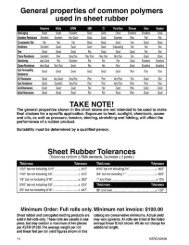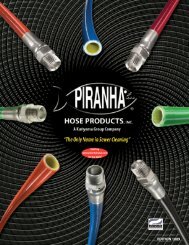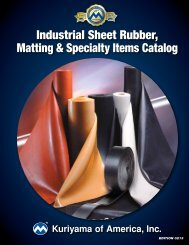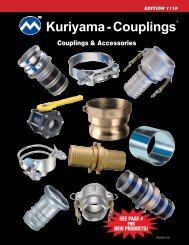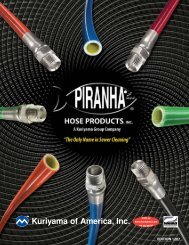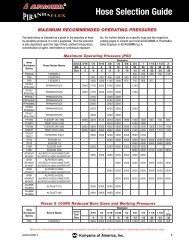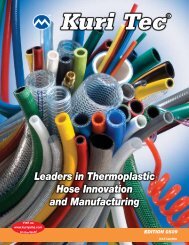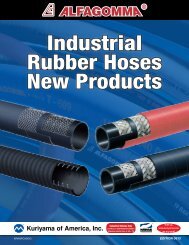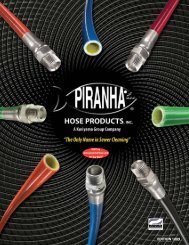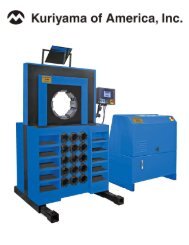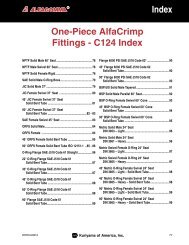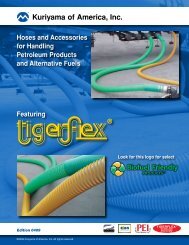Create successful ePaper yourself
Turn your PDF publications into a flip-book with our unique Google optimized e-Paper software.
<strong>Accuflex</strong> <strong>Beverage</strong> <strong>Transfer</strong> <strong>Products</strong>Frequently Asked Questions (continued)compared to the rest of the hose or tubing wall, the barrierlayers offer effective protection against flavor ingression.When hose or tubing is exposed to cleaning fluids or environmentalcontaminants, or when the lines are confined in closeproximity to each other, as in a bundle or conduit, the flavors ofbeverages inside the hose or tubing can be affected by flavoringression or cross-tasting. We recommend that barrier-stylehoses, tubing, or bundles be used in these situations.Q: Do some flavors cross-taste more than others?A:Most non-barrier hoses and tubes use polyethylene asthe primary material. Polyethylene allows most organichydrocarbons to permeate relatively quickly without causingany physical change in the polyethylene itself. The rate ofpermeation is approximately the same for each flavor, but thelevel at which a given flavor can be detected may vary greatly.Pungent flavors such as root beer, cherry, or strawberry arevery strong, and can be detected at very low levels, as comparedto non-pungent flavors. Therefore, a pungent flavor willbe detected as a contaminant in a non-pungent flavor relativelyeasily. Furthermore, fruit flavors based on limonene arereadily absorbed and held by polyethylene, which releasesit slowly to the atmosphere or the beverage contained insidethe tube. The high absorption level and slow release are thereasons why fruit flavors are so difficult to flush out of polyethylenehose or tubing.Q: Water, syrup or CO . . . which hose or tube is best2for what?A:The main criteria in choosing the proper hose or tubeare the physical conditions such as pressure, temperature,and environment. Particular attention must be paid topressurized lines such as CO 2transfer lines in which higherpressures may require the use of hose instead of tubing,keeping in mind that pressure ratings are reduced at highertemperatures.Secondly, the environment must be considered to determineif there is a need for barrier protection, such as installations ina floor chase or individual lines in a bundle carrying pungentflavors. Water lines in particular must be protected from contamination,whether run inside a bundle or alongside it.Q: What size and type of clamp should be used?To obtain uniform compression around the tube orA: hose, we recommend the use of a stepless ear-typeclamp. The clamp must be sized so that it will still slide overthe tube after the barbed fitting is inserted, and exert sufficientcompression on the materials before the clamp is fully closed.When soft materials are involved, it must be recognized thatthe clamp will sink into the materials somewhat, perhapsnecessitating a smaller sized clamp. When properly sized, thesides of the ear should not be touching each other when theclamp is installed.Q:A:How tightly can beverage lines be bent in apermanent installation?The minimum bend radius values shown in this catalogrepresent the smallest curvature to which a productshould be exposed in an positive pressure installation at roomtemperature, as measured in the inside of the curve. Minimumbend radius depends upon diameter, wall thickness, materialhardness and elasticity, and application conditions. If negativepressures or elevated temperatures are involved, larger valuesshould be considered. As a general rule of thumb, a minimumbend radius for a hose or tube is 10 times the OD of the product.This is a conservative value and should apply to mostproducts, unless very thin walled hoses or tubes are involved.Q:A:What fire regulations must be considered wheninstalling beverage lines?All beverage lines must be installed in accordancewith all applicable regulations and building codes. Themost common questions involve the use of lines in ceilings,and, in particular, in plenums. A plenum is an area from whichair can be drawn into the living space in a building through theheating or air conditioning systems. A plenum may be a specificair duct, or could be an entire attic area. In the event of afire, it is important that the materials inside a plenum not generateany significant level of toxic smoke. Halogenated materialssuch as PVC are of concern in such areas, and should beenclosed in a fire resistant chase.All materials used in a plenum must be “non-combustible” asdefined by standards such as ASTM E-84 in the USA or CAN/ULC S102.2 in Canada. In both of these standards, the maximumvalues for flame spread and smoke generation are 25and 50 respectively. Since the primary concerns in the designof beverage hose and tubing are taste integrity and healthsafety, flame retardant additives cannot be added directly toany components that may be exposed to the beverage. Therefore,the products must contain barrier layers to ensure thatno flame retardants migrate to the contact surface. <strong>Accuflex</strong>’sBev-Seal Ultra ® Series 235FR, 175FR, and 974FR Fire Resistanttubing, hose and bundles satisfy these requirementswith a 0/0 rating.Q:A:What is the difference between standardsNSF-51 and NSF-61?The National Sanitation Foundation has issued twostandards that can relate directly to beverage applications.Standard NSF-51 covers Food Equipment and Related<strong>Products</strong>, Components and Materials, and includes dispensersand other equipment involved in the preparation, storage ortransfer of foods and beverages (including alcoholic beverages).The criteria relate somewhat to FDA regulations. StandardNSF-61 covers Drinking Water System Component – HealthEffects, and includes all equipment that comes in contact withdrinking water. These criteria are based on EPA guidelines.Many of our hose and tubing products carry both NSF-51 andNSF-61 listings, so that they can be used with both drinkingwater and prepared beverages.Because we continually examine ways to improve our products, we reserve the right to alter specifications without notice.TM18 <strong>Accuflex</strong> ABPCA0904



